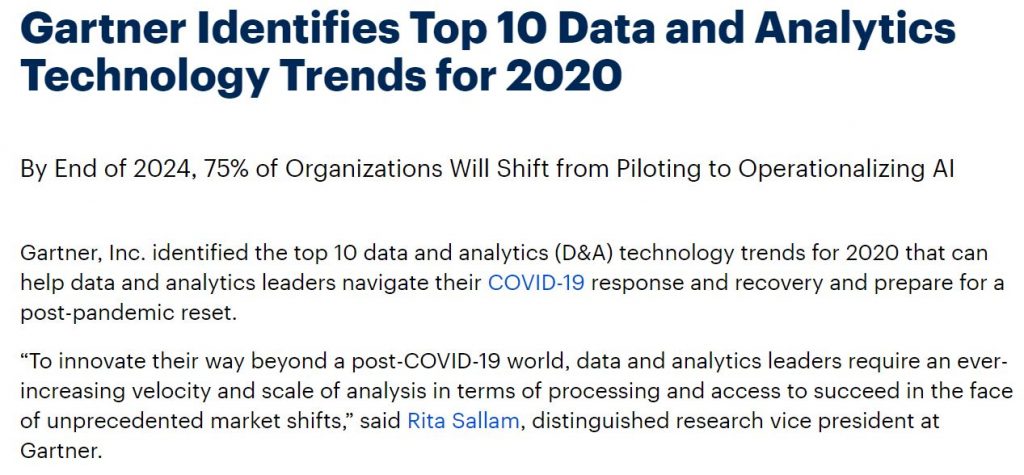Gartner: Analytics Trends 2020
4. Oktober 2020 09:21 Uhr | Dr. Ulrich Kampffmeyer | Permalink

Gartner hat im Juni 2020 eine Trendanalyse zu (Big) Data & Analytics veröffentlicht, die bereits die Auswirkung der Covid-19-Krise berücksichtigt. Hier sind zunächst die Auswirkungen der Krise auf Heimarbeit zu sehen, aber mehr noch die Chancen, die sich durch weitere Automatisierung ergeben (was dann wieder die Notwendigkeit von Heimarbeit reduziert).
Gartner kommt zu dem Ergebnis, daß bis zum Ende des Jahres 2024 rund 75% aller Organisationen und Unternehmen aus dem Versuchs- und Pilotierungsstadium heraus sind und Künstliche Intelligenz operativ einsetzen werden. Auch Graph-Datenbanken, Machine Learning, Blockchain, Business Intelligence, Cloud und andere Technologien spielen bei Analytics eine wichtige Rolle. Die Bedeutung von Analytics für die Datenmassen von IoT wäre zumindest berücksichtigenswert gewesen.
Die von Gartner veröffentlichte Kurzfassung der Trends beschreibt folgende Entwicklungen (die Vollversion der Studie ist nur für Gartner-Kunden verfügbar):
<Zitat> Trend 1: Smarter, Faster, More Responsible AI
By the end of 2024, 75% of organizations will shift from piloting to operationalizing artificial intelligence (AI), driving a 5 times increase in streaming data and analytics infrastructures.
Within the current pandemic context, AI techniques such as machine learning (ML), optimization and natural language processing (NLP) are providing vital insights and predictions about the spread of the virus and the effectiveness and impact of countermeasures.
Other smarterAI techniques such as reinforcement learning and distributed learning are creating more adaptable and flexible systems to handle complex business situations; for example, agent-based systems that model and simulate complex systems.
Trend 2: Decline of the Dashboard
Dynamic data stories with more automated and consumerized experiences will replace visual, point-and-click authoring and exploration. As a result, the amount of time users spend using predefined dashboards will decline. The shift to dynamic data stories that leverage for example augmented analytics or NLP, means that the most relevant insights will stream to each user based on their context, role or use.
Trend 3: Decision Intelligence
By 2023, more than 33% of large organizations will have analysts practicing decision intelligence, including decision modeling. Decision intelligence brings together several disciplines, including decision management and decision support. It provides a framework to help data and analytics leaders design, model, align, execute, monitor and tune decision models and processes in the context of business outcomes and behavior.
Trend 4: X Analytics
Gartner coined the term “X analytics” to be an umbrella term, where X is the data variable for a range of different structured and unstructured content such as text analytics, video analytics, audio analytics, etc.
During the COVID-19 pandemic, AI has been critical in combing through thousands of research papers, news sources, social media posts and clinical trials data to help medical and public health experts predict disease spread, capacity-plan, find new treatments and identify vulnerable populations. X analytics combined with AI and other techniques such as graph analytics will play a key role in identifying, predicting and planning for natural disasters and other crises in the future.
Trend 5: Augmented Data Management
Augmented data management uses ML and AI techniques to optimize and improve operations. It also converts metadata from being used in auditing, lineage and reporting to powering dynamic systems.
Augmented data management products can examine large samples of operational data, including actual queries, performance data and schemas. Using the existing usage and workload data, an augmented engine can tune operations and optimize configuration, security and performance.
Trend 6: Cloud is a Given
By 2022, public cloud services will be essential for 90% of data and analytics innovation. As data and analytics moves to the cloud, data and analytics leaders still struggle to align the right services to the right use cases, which leads to unnecessary increased governance and integration overhead.
The question for data and analytics is moving from how much a given service costs to how it can meet the workload’s performance requirements beyond the list price. Data and analytics leaders need to prioritize workloads that can exploit cloud capabilities and focus on cost optimization when moving to cloud.
Trend 7: Data and Analytics Worlds Collide
Data and analytics capabilities have traditionally been considered distinct entities and managed accordingly. Vendors offering end-to-end workflows enabled by augmented analytics blur the distinction between the two markets.
The collision of data and analytics will increase interaction and collaboration between historically separate data and analytics roles. This impacts not only the technologies and capabilities provided, but also the people and processes that support and use them. The spectrum of roles will extend from traditional data and analytics to information explorer and citizen developer as examples.
Trend 8: Data Marketplaces and Exchanges
By 2022, 35% of large organizations will be either sellers or buyers of data via formal online data marketplaces, up from 25% in 2020. Data marketplaces and exchanges provide single platforms to consolidate third-party data offerings and reduce costs for third-party data.
Trend 9: Blockchain in Data and Analytics
Blockchain technologies address two challenges in data and analytics. First, blockchain provides the full lineage of assets and transactions. Second, blockchain provides transparency for complex networks of participants.
Outside of limited bitcoin and smart contract use cases, ledger database management systems (DBMSs) will provide a more attractive option for single-enterprise auditing of data sources. By 2021, Gartner estimates that most permissioned blockchain uses will be replaced by ledger DBMS products.
Trend 10: Relationships Form the Foundation of Data and Analytics Value
By 2023, graph technologies will facilitate rapid contextualization for decision making in 30% of organizations worldwide. Graph analytics is a set of analytic techniques that allows for the exploration of relationships between entities of interest such as organizations, people and transactions. It helps data and analytics leaders find unknown relationships in data and review data not easily analyzed with traditional analytics. </Zitat>
